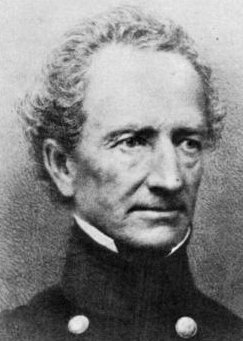James Wolfe Ripley facts for kids
Quick facts for kids
James Wolfe Ripley
|
|
|---|---|
 |
|
| Born | December 10, 1794 Windham County, Connecticut |
| Died | March 16, 1870 (aged 75) Hartford, Connecticut |
| Place of burial |
Springfield Cemetery in Springfield, Massachusetts
|
| Allegiance | United States Union |
| Service/ |
United States Army Union Army |
| Years of service | 1814–1863 |
| Rank | |
| Commands held | 5th Chief of Ordnance (1861–1863) |
| Battles/wars | American Civil War |
James Wolfe Ripley (born December 10, 1794 – died March 16, 1870) was an American soldier. He became a brigadier general in the Union Army during the Civil War. In 1861, he was chosen to be the 5th Chief of Ordnance for the U.S. Army. This meant he was in charge of all weapons and military supplies. He made some important decisions about army weapons early in the war. However, he also delayed the use of newer, faster-firing guns like the Gatling gun and the Spencer rifle. Many historians have since discussed these choices.
Contents
Early Life and Military Career
James Wolfe Ripley was born in Windham County, Connecticut. He studied at West Point, a famous military school, and graduated in 1814. After graduating, he became a second lieutenant in the artillery. He helped defend Sacketts Harbor during the War of 1812.
In 1817 and 1818, he served with Andrew Jackson during the Seminole War in Florida. He was promoted to first lieutenant during this time. By 1825, he had become a captain.
Key Commands and Promotions
From 1832 to 1833, Ripley was in charge of U.S. forces in Charleston harbor. This was during a time called the nullification movement, when South Carolina strongly disagreed with federal laws. In 1838, he was promoted to major in the ordnance department. He then commanded the Kennebec Arsenal from 1833 to 1842.
Leading the Springfield Armory
Ripley became the superintendent, or leader, of the Springfield Armory from 1842 to 1854. This was a very important weapons factory. Some historians even called it "Ripley's Monument" because of his excellent work there. He made the buildings and grounds better and increased how many weapons were made while lowering costs. He also helped create the 1855 model .58 caliber rifled musket. This gun later became the main weapon for Union soldiers during the Civil War.
Ripley was very strict about following army rules and stopping bad practices at the factory. Because of this, some people didn't like him. But his bosses always supported him because he did such a great job.
In 1854, he moved to the Watertown Arsenal as its commander. He was then a lieutenant colonel. Later, he became the chief of ordnance for the Pacific Coast Department and inspected other arsenals.
Civil War Service
When the Civil War began in early 1861, Ripley was quickly promoted. He became a colonel in April and a brigadier general in August. He was also appointed the 5th Chief of Ordnance of the United States Army.
At the start of the war, the U.S. forces didn't have many heavy rifled cannons. Ripley quickly ordered old smoothbore cannons to be changed into rifled ones. He also ordered new Parrott guns to be made.
Debates Over New Weapons
However, Ripley made some controversial decisions. He refused to buy more modern rifle-muskets for the infantry soldiers. He believed the army had enough old smoothbore muskets, which he thought could be updated (though this turned out to be difficult). He also strongly opposed using new breech-loading repeating rifles. These guns could fire many shots quickly without reloading. Ripley worried that soldiers would waste ammunition and not be disciplined enough with such weapons.
Many historians have criticized this decision. They argue that the lack of modern weapons for the Union army might have made the war last longer. Other historians, however, point out that the Union army's supply system was not ready for the huge amount of ammunition these new guns would need. They suggest that trying to supply these guns might have slowed down the army too much.
Some individual army units bought these new weapons themselves. They found them very effective, even though they sometimes had issues in long battles. These units usually didn't have trouble getting enough ammunition. Because Ripley continued to oppose these new, faster-firing rifles, he was replaced as the head of the Ordnance Department on September 15, 1863.
Later Life and Legacy
After leaving the Ordnance Department, Ripley became an inspector of fortifications along the New England coast. He retired from active service. On March 8, 1866, President Andrew Johnson nominated Ripley to be a brevet major general in the regular army. This was an honorary promotion for his service. The U.S. Senate confirmed this on July 14, 1866.
James Wolfe Ripley passed away on March 16, 1870, in Hartford, Connecticut. He is buried in Springfield, Massachusetts.
His nephew, Roswell S. Ripley, also served in the Civil War. He was a brigadier general for the Confederate side.

